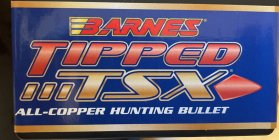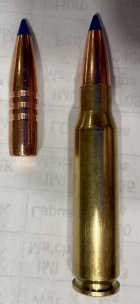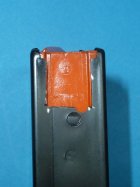You are right. On the top of the box is written Tipped TSX instead of TTSX so I missed that. Should I discard the loads I've set to 2.80" C.O.A.L. (pull the bullets, dump the powder, resize the cases)? My hunch is yes.The only problem I see with this load is using the wrong bullet to extrapolate data.
The bullet in the top photo is not a TSX, it’s a TTSx. the second “T” is important as for Barnes that designates a tipped bullet.
If you note the Barnes data, the TTSX requires a much shorter COL, likely because it will jam at 2.810.
Make certain of your bullet part number before loading any thing.
This is where mixing data and components can get interesting.
Install the app
How to install the app on iOS
Follow along with the video below to see how to install our site as a web app on your home screen.
Note: This feature may not be available in some browsers.
You are using an out of date browser. It may not display this or other websites correctly.
You should upgrade or use an alternative browser.
You should upgrade or use an alternative browser.
Question on bullet seating depth
- Thread starter oaklandraider76
- Start date
You are right. The top of the box reads Tipped TSX instead of TTSX. My bad.The only problem I see with this load is using the wrong bullet to extrapolate data.
The bullet in the top photo is not a TSX, it’s a TTSx. the second “T” is important as for Barnes that designates a tipped bullet.
If you note the Barnes data, the TTSX requires a much shorter COL, likely because it will jam at 2.810.
Make certain of your bullet part number before loading any thing.
This is where mixing data and components can get interesting.

dellet
Gold $$ Contributor
This is where things get tricky with load manuals and why starting low is the rule.
Barnes lists the same starting load for both bullets. The confusing part is that the TTSX has a COL about .100” shorter, so you have to be concerned about where it contacts the lands.
It go here and check out the lengths of the two bullets, you find that the TTSX is also .100” longer than the the TSX. So not only is it seated deeper by COL, you have an additional .100” due to bullet length. Roughly .200” more bullet in the case.
 www.jbmballistics.com
www.jbmballistics.com
Somehow magically the same powder load produces the same pressure.
With your existing load, I would not pull them down. I would check to see if they do actually hit the lands. If they don’t, your well below starting data.
If they hit the lands, you can just seat them deeper and still be at starting load data.
If you’re worried or want to learn something, you could seat a few of those at different depths down to the Barnes length and watch what accuracy and velocity does with the change. Or Set them aside, load more to start your load work up and some place those will work into the test ladder.
They aren’t going to hurt anything use sitting thereuntil you have a better idea of what load works best in your rifle.
The big take away is to confirm you components.
Barnes lists the same starting load for both bullets. The confusing part is that the TTSX has a COL about .100” shorter, so you have to be concerned about where it contacts the lands.
It go here and check out the lengths of the two bullets, you find that the TTSX is also .100” longer than the the TSX. So not only is it seated deeper by COL, you have an additional .100” due to bullet length. Roughly .200” more bullet in the case.
JBM - Bullet Length List
Somehow magically the same powder load produces the same pressure.
With your existing load, I would not pull them down. I would check to see if they do actually hit the lands. If they don’t, your well below starting data.
If they hit the lands, you can just seat them deeper and still be at starting load data.
If you’re worried or want to learn something, you could seat a few of those at different depths down to the Barnes length and watch what accuracy and velocity does with the change. Or Set them aside, load more to start your load work up and some place those will work into the test ladder.
They aren’t going to hurt anything use sitting thereuntil you have a better idea of what load works best in your rifle.
The big take away is to confirm you components.
RegionRat
Gold $$ Contributor
After running many load developments with Barnes TTSX, I will add that every one of them wanted more jump than I used to start them with. They like to be seated deep.
We were forced to change to non-lead hunting loads in the Pacific Condor Range many years ago, and it forced me to make the Barnes bullets work for those of us who continued to hunt in that area.
Those zones covered some very good wild pig and deer areas, plus any pest or predator shooting made it necessary. Later, they flipped the whole state non-lead for hunting in spite of the data showing no link to the blood lead levels of the Condors. That forced even more friends to ask for help if they hunted at all in CA. I have lost count of how many times I have used the jump bring these to life. They respond well to seating depth tuning and generally jump more than folks are used to these days.
I would test what you have now and get comfortable with your charge and loading process, then expect to tune the load with seating depth if you are not happy with the groups.
Another suggestion I will make is purely anecdotal and other than observed behavior I can't explain it...
Make sure you squeaky clean the rig before shooting the Barnes copper monolith bullets. For whatever reason it takes a while to settle them down if the rig has been run with typical bullets and not cleaned first. Plan on making a good handful of foulers for the first sessions and look the other way before you start judging the groups.
They are good hunting bullets as long as you hit things fast enough for them to perform.
We were forced to change to non-lead hunting loads in the Pacific Condor Range many years ago, and it forced me to make the Barnes bullets work for those of us who continued to hunt in that area.
Those zones covered some very good wild pig and deer areas, plus any pest or predator shooting made it necessary. Later, they flipped the whole state non-lead for hunting in spite of the data showing no link to the blood lead levels of the Condors. That forced even more friends to ask for help if they hunted at all in CA. I have lost count of how many times I have used the jump bring these to life. They respond well to seating depth tuning and generally jump more than folks are used to these days.
I would test what you have now and get comfortable with your charge and loading process, then expect to tune the load with seating depth if you are not happy with the groups.
Another suggestion I will make is purely anecdotal and other than observed behavior I can't explain it...
Make sure you squeaky clean the rig before shooting the Barnes copper monolith bullets. For whatever reason it takes a while to settle them down if the rig has been run with typical bullets and not cleaned first. Plan on making a good handful of foulers for the first sessions and look the other way before you start judging the groups.
They are good hunting bullets as long as you hit things fast enough for them to perform.
Yes!Make certain of your bullet part number before loading any thing.
This is where mixing data and components can get interesting.
"INTERESTING" is one way of putting it.
I could not stress enough the importance of only having on the bench, what you are currently using and have doubled checked to be correct.
Just the opposite for any reasonable seating depth; enough reduction will of course increase pressure. Notice the concern is quite valid in handguns. Setback on loading into the chamber in a semi-automatic pistol will indeed blow cases and worse. But a little knowledge is a dangerous thing in reloading so it does pay to ask.My main concern is that pushing the bullet this far into the case may cause unexpected jumps in pressure.
In fact in rifles the effect of increased seating depth reducing case volume is overcome by the free bore effect of a longer running start on the lands - see e.g. Weatherby or 9x23 in handguns - This is quite pronounced in today's non-toxic or monometal hard bullet; which are harder to engrave. Hence the advice to start clear of the lands. See writings by John Barsness for an extended discussion over time and lab testing. Brownell's aging book on pressure factors from Handloader magazine and reprinted paper and electronic is a useful resource but Barsness and friends is probably more accessible today. Google will find it with Barsness Denton and others in an authoritative discussion.
Fortunately, Dr. Brownell was curious about this issue a few decades ago, and experimentally answered the question.
In the graphic, note that COL is along the top of the graph, and seating depth is along the bottom of the graph.
As you increase cartridge length, available volume increases. This reduces pressure.
As you increase cartridge length, you also decrease the distance to the lands. When the bullet engages the lands, pressure behind it increases until the bullet is engraved.
These two effects work against each other. At some points, one wins, and at other points, the other wins.
What you get is maximum pressure with either very long or very short COL, with a dip in the middle.
Denton
jepp2
Gold $$ Contributor
Two options are use a SLED and single load or window your magazine (gains me over 0.100" in .223/5.56).Since I'm constrained by the length of the magazine I can't move the bullet out any more.
Attachments
I have reseated the bullets to 2.735" C.O.L. I'm guessing that Barnes recommends this because this bullet likes a bit of jump to the lands. I plan on working up the ladder to see if I can get decent accuracy out of a load that also results in enough velocity for proper expansion. If this doesn't work out, I've been getting very good results with the Hornady 165 gr BTSP Interlocks. I live in Tennessee so nothing prevents me from throwing lead-core bullets at deer and bear. Also, my accuracy needs to be just good enough to get the job done so I'm not chasing sub-MOA groups. If I can put three rounds in a baseball at 200 yards I'm happy. Again, thanks for all the input. You folks are a great resource.Just the opposite for any reasonable seating depth; enough reduction will of course increase pressure. Notice the concern is quite valid in handguns. Setback on loading into the chamber in a semi-automatic pistol will indeed blow cases and worse. But a little knowledge is a dangerous thing in reloading so it does pay to ask.
In fact in rifles the effect of increased seating depth reducing case volume is overcome by the free bore effect of a longer running start on the lands - see e.g. Weatherby or 9x23 in handguns - This is quite pronounced in today's non-toxic or monometal hard bullet; which are harder to engrave. Hence the advice to start clear of the lands. See writings by John Barsness for an extended discussion over time and lab testing. Brownell's aging book on pressure factors from Handloader magazine and reprinted paper and electronic is a useful resource but Barsness and friends is probably more accessible today. Google will find it with Barsness Denton and others in an authoritative discussion.
Fortunately, Dr. Brownell was curious about this issue a few decades ago, and experimentally answered the question.
In the graphic, note that COL is along the top of the graph, and seating depth is along the bottom of the graph.
As you increase cartridge length, available volume increases. This reduces pressure.
As you increase cartridge length, you also decrease the distance to the lands. When the bullet engages the lands, pressure behind it increases until the bullet is engraved.
These two effects work against each other. At some points, one wins, and at other points, the other wins.
What you get is maximum pressure with either very long or very short COL, with a dip in the middle.
Denton

Similar threads
- Replies
- 0
- Views
- 1,065
Upgrades & Donations
This Forum's expenses are primarily paid by member contributions. You can upgrade your Forum membership in seconds. Gold and Silver members get unlimited FREE classifieds for one year. Gold members can upload custom avatars.

Click Upgrade Membership Button ABOVE to get Gold or Silver Status.
You can also donate any amount, large or small, with the button below. Include your Forum Name in the PayPal Notes field.
To DONATE by CHECK, or make a recurring donation, CLICK HERE to learn how.

Click Upgrade Membership Button ABOVE to get Gold or Silver Status.
You can also donate any amount, large or small, with the button below. Include your Forum Name in the PayPal Notes field.
To DONATE by CHECK, or make a recurring donation, CLICK HERE to learn how.










